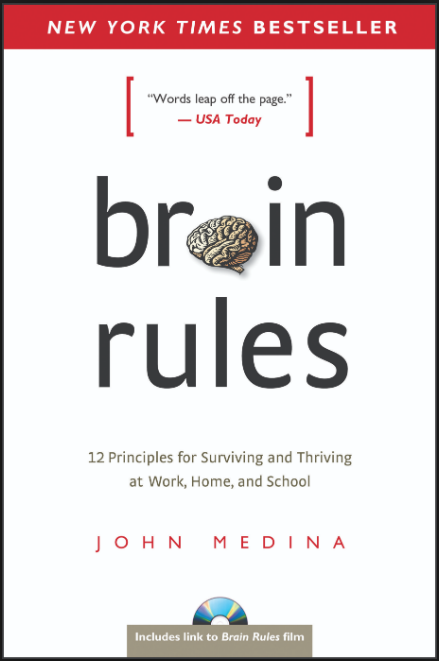 “Go ahead and multiply the number 8,388,628 x 2 in your head.
“Go ahead and multiply the number 8,388,628 x 2 in your head.
“Can you do it in a few seconds? There is a young man who can double that number 24 times in the space of a few seconds. He gets it right every time.
“There is a boy who can tell you the precise time of day at any moment, even in his sleep.
“There is a girl who can correctly determine the exact dimensions of an object 20 feet away.
“There is a child who at age 6 drew such vivid and complex pictures, some people ranked her version of a galloping horse over one drawn by da Vinci.
“Yet none of these children have an IQ greater than 70.”
So begins the introduction to an intriguing book I recently read called, “Brain Rules – 12 Principles for Surviving and Thriving at Work, Home, and School.”
It’s written by molecular biologist and brain scientist, John Medina.
Now, I’m no biologist.
I don’t even have a biology background.
But I’m fascinated by neuroscience, how the brain works and its magical capabilities.
As a copywriter, marketer or online business owner – you should be too.
Because gaining a deeper understanding of human nature… how we learn and process information… how we make decisions… and what makes our prospects, customers and clients tick is the fastest way to crank up your profits.
So today I want to share with you five secrets from John’s research.
I encourage you to pick up a copy of his book to learn the rest.
As you’ll see, this stuff is not rocket science (and some will even seem obvious) …
… Yet the people who are out there creating the majority of training courses, programs and webinars that I come across are clearly not using it.
I challenge you to be among the first.
Secret #1: The Myth of Multitasking

I meet a lot of people who brag about their ability to multitask, almost wearing it on their sleeve as if it were a badge of honor.
But research has shown time and again that the human brain wasn’t designed to multitask.
In fact, the very act of trying to do so has negative long-term effects on brain function.
A 2009 study by Stanford researcher Clifford Nass challenged 262 college students to complete a variety of experiments that involved filtering irrelevant information, switching among tasks, and using working memory.
Expecting to find multitaskers outperforming non-multitaskers, they were shocked to discover much the opposite.
Not only were multitaskers less effective when multitasking, that loss of effectiveness spilled over into other areas. It even left them less effective when they were focusing on a single activity, and weren’t trying to multitask at all.
The study revealed that our brain works at half capacity when we are forced to multitask, and our error rate goes up by 50%!
Those effects are long term, not just in the moment.
So what does this have to do with us as online business owners?
One of the worst problems I see with online courses (or any other type of training) is a “throw it at the wall and see what sticks” approach to conveying information.
It’s disjointed … lacks focus … and tries to convey too much information too rapidly.
…All in a haphazard effort to overwhelm the person with so much “value” that they immediately become raving fans.
Unfortunately, it’s more often completely the opposite.
There’s so much input coming at them, so quickly, it quite literally overloads the circuits of the brain. It leaves the person confused, frustrated, and discouraged.
Their brain simply shuts down, and one of two things happens:
- They ask for a refund and you never hear from them again.
- They fail to follow through and you never hear from them again.
Either way, you’re out potential referrals… repeat business… and a whole lot of profits.
So what can you do about this?
Practice what’s called microlearning to prevent cognitive overload.
Microlearning means to deliver content to learners in a logical, step-by-step fashion, and in smaller, specific bursts.
Another word for it is chunking.
In psychology or linguistic analysis, chunking refers to the act of grouping together connected items, words or thoughts so they can be stored or processed as single concepts.
TED Talks are a great example of microlearning.
When someone delivers a TED Talk, it’s generally in the range of 10 to 15 minutes long.
In fact, the people at TED Talk have an 18-minute rule.
You can be Bill Gates, Steve Jobs, Anthony Robbins – it doesn’t matter. You’ve got a maximum of 18 minutes to spit out what you want to say.
The people behind the TED Talk discovered that 18 minutes is long enough to be serious, yet short enough to hold attention.
Most importantly, it’s short enough to be memorable.
You absorb and remember more, because it’s delivered in smaller, bite-sized chunks.
Studies show that students zone out after about 15-20 minutes in a lecture.
Beyond that, our brains go into cognitive overload, and absorption and retention crash.
Secret #2: Emotions Influence Our Learning

In my last post, I told the story of how my daughter’s interest in interior design was quickly snuffed out by an expert’s complete lack of emotion on the topic.
The brain is highly influenced by the emotions (or lack thereof) of the teacher or trainer.
Our limbic system – the emotional center of the brain – has the ability to open up, or shut off, access to learning and memory.
If you’re bored out of your mind, your limbic system quickly gets frustrated and shuts down.
That’s why we talk so much about the use of stories here on The EMAIL ALCHEMIST blog, and in the EMAIL ALCHEMY training programs.
When someone tells you a good story, especially when it touches you on an emotional level, your limbic system fires on all cylinders.
It engages you… it inspires you… and it opens your mind.
Your ability to learn and retain information skyrockets.
People remember strategies and principles much more when they are connected to stories than if they are simply relayed as a laundry list of “next steps.”
The sad reality today is, student’s brains are shutting off emotionally because they are absolutely uninspired and unengaged.
It’s happening all over the world … at work, home and school.
For many, it’s impacting the trajectory of their life.
My daughter could have been a great interior designer, but a single course derailed her.
So what do we do about this?
FIRST, offer a warm and welcoming atmosphere.
Include a video on the very first screen that immediately makes them feel welcome, and that emotionally reinforces what they’re about to learn, discover and accomplish.
The selling doesn’t end when you’ve sold someone on buying your program.
You’ve got to continue to sell them on completing it and taking action.
SECOND, inspire them with stories and examples.
Help them to mentally insert themselves into the shoes of someone who has already accomplished what they hope to … so they not only retain things more because they’ve been inspired, but are also moved to take action.
They’ll quickly attach emotions to your program, whether positive or negative.
Make sure they’re positive.
THIRD, actively engage them to apply what they’re learning.
If you can get them to quickly use what you’re teaching them, they’re more likely to continue that progress.
Forward progress, even if minimal, creates positive emotions.
Secret #3: The Snooze Factor

Many experts get so wrapped up with just getting their information out there, they forget about the actual delivery of their training.
It ends up being crazy boring, and everybody is left snoozing on the other end.
You’ve got to put as much thought into how you’re delivering your information as you do the information itself. That’s especially true when it comes to online learning, where a student can’t see your body language and visual cues.
There is a far greater chance of losing them to distractions, or simply losing their interest.
So what can we do to make sure we are not delivering boring stuff?
FIRST, include relevant visuals.
A great tool if you’re just getting started is HaikuDeck.com.
It allows you to quickly and easily integrate images and other graphics into your slides that are contextually relevant, making it more engaging.
Of course, PowerPoint and other presentation tools are great too.
SECOND, integrate a heaping helping of stories and scenarios.
They engage and inspire, and greatly increase learning and retention.
THIRD, create opportunities for application.
Tell them what they need to do next. Give them activities to practice, reinforce and implement what you’re teaching them.
FOURTH, facilitate interaction.
Set up a private Facebook group, or even a WordPress forum plugin, to get people involved and interacting with each other.
Secret #4: Multimedia Improves Brain Performance

A lot of fascinating studies have been done about the use of multimedia.
They show that when you include such things as sound effects, music, audio narration and images the student is able to retain far more of the content.
Of course, multimedia creates better engagement.
But it also helps your brain to learn and digest the information in a variety of ways, as it creates multiple levels of learning and memory.
Think of different shelves on a bookshelf within your brain.
One shelf may be your basic rote memorization.
A second shelf may be visuals that provide context and allow you to apply the principles you’re learning, such as examples and case studies…
A third shelf may be visualization exercises that guide you in using the new principles.
The more varied the experience, the greater the learning and retention.
So how do we do this?
FIRST, incorporate video and audio as much as possible.
Don’t force your students to learn solely from a bunch of written material.
If you don’t want to be on camera, for whatever reason, that’s fine.
You can create video presentations using slide decks and screen recordings.
Perhaps, even include musical interludes at the beginning and end of each video segment, to help keep emotions high and activate deep learning.
And always have an audio version of your training available, even if it’s heavy on demonstration, as it provides a secondary way for them to review the information.
SECOND, incorporate lots of worksheets, handouts, action guides, etc.
These types of supplemental materials invite your students to work with the material, and to integrate it more easily and quickly.
THIRD, consider finishing out each module or primary segment of your training with a test or quiz.
This is another great way to get them to interact and work with the material. Again, so they can integrate it more quickly.
Secret #5: Repeat to Remember

The photo above represents what’s known as first-level memory retention.
He’s forced to write the same phrase over and over again, so it will be forever etched in his brain.
It’s like learning your multiplication tables when you were in grade school.
I remember sitting with a set of flash cards for hours, going over them again and again. After enough repetition, those tables moved into my long-term memory.
That’s why I can think 7 x 7 and 49 instantly flashes into my brain, without even thinking.
So how do we use this?
FIRST, repeat the “must know” core principles throughout your training.
Not multiple times in a row, so it gets annoying, but at various strategic touchpoints. Even if it’s as simple as repeating them at the beginning, middle and end.
Every time the brain receives new stimuli, the connections between the neurons strengthen.
But in order to really strengthen those connections, you need repetition.
SECOND, provide relevant context by which to remember the core principles.
This could be sharing metaphors, analogies or examples. Or perhaps mnemonic association, where you’re using an acronym of some sort.
Think about a child that puts their hand on a hot stove.
You can tell them “don’t touch the stove, it’s hot!” until you’re blue in the face.
It’s not going to mean the same thing as if the child touches it and gets burned. Suddenly, the child has memorable context.
The child will remember that experience forever, at a far deeper level.
That’s what we’ve got to be thinking about when we create our training programs.
It’s Time to Use It or Lose It …
Just like your brain, you can use these secrets or simply forget about them.
Before you decide which, consider this…
People who remember more of our training material, with positive emotions, will have a far better chance of taking action and applying it.
Many of those people will buy provigil more of our courses and share them with other people.
You see the ripple effect here?
This isn’t just about learning some obscure scientific facts about the brain.
It’s about building a successful, profitable, long-term online business.
I said in the beginning…
This stuff is not rocket science, and much of it will seem beyond the obvious.
The question is…
Are you actually using it?
Very good. Have to agree 100%
Thank-you for the article. Now let’s see if I can really put this into action. 🙂